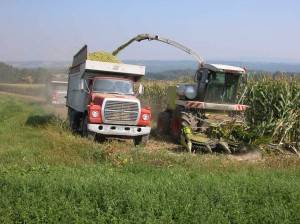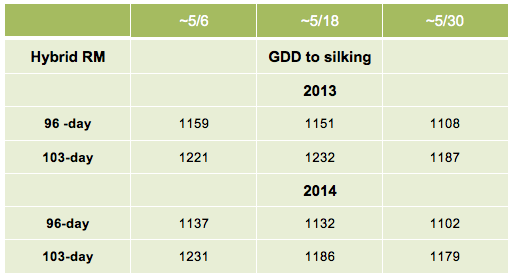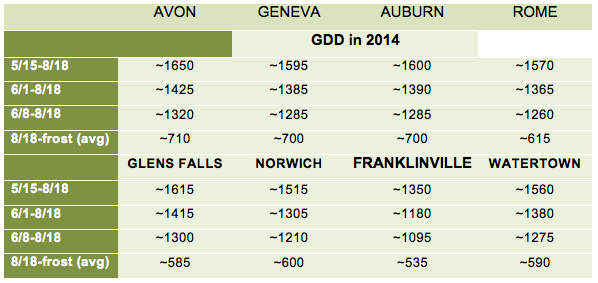
Corn producers in NY only planted ~20% of the crop by May 15, ~60% by June 1 and ~80% by June 8th. Most locations in NY received ~30 to 50 growing degrees (GDD) above normal from June 1 through July 15 so fears of immature or wet corn at harvest for late-planted corn were allayed through mid-July. Since then, however, most locations in NY, especially the Finger Lakes and western NY, have received ~75-150 GDD below normal through August 18th. Consequently, fears of immature corn silage, or immature grain or wet and low-test weight grain have once again risen. What is the probability of this doom and gloom scenario?
I think that fears are overblown at the moment because of three important factors. First, the National Weather Service (NWS) has predicted above normal temperatures in NY for the final 2 weeks of August (don’t ask me why I still believe them!). If this holds true, August will come in only ~40-80 GDD below normal for the month and the crop in eastern and northern NY will be close to normal development, whereas the crop in central and western NY will be about 5 days behind. Second, many growers dialed back their maturity (as recommended in the May 16th posting) by 5-10 days once planting was delayed until early June, which greatly enhances the probability of maturation before a killing frost . Finally, corn hybrids (90-100 day relative maturity) that are planted in early June require about ~75-100 less GDD to mature than when planted in early May. In other words, if a grower planted a 100 day hybrid in early May, that hybrid would require about 1200 GDD to silk, another 850 GDD to attain 66-68% moisture for silage harvest (2050 GDD total), and about another 150 GDD to attain black layer (2200 GDD total). The same hybrid, however planted during the first week of June would require about 1150 GDD to silk, and 800 GDD to 66-68% moisture for silage harvest (1950 GDD total), and another ~150 GDD to black layer (~2100 GDD total).
Will this scenario of less GDD to maturation with delayed planting hold true again for this year? As some of you know, we planted a 96 and a 103-day hybrid at Aurora at five planting dates ranging from early April to very late May (May 30th) in 2013 and 2014. The 96-day hybrid required ~1140 GDD to silk when planted on May 7th in 2014 but only ~1100 GDD to silk when planted on May 30th (Table 1). Likewise, the 103-day hybrid required ~1230 GDD to silk when planted on May 7th in 2014 but only ~1180 GDD to silk when planted on May 30th (Table 1). If planting were pushed back another week, the difference in GDD would probably be greater. I believe that the shortening of the silking to ½ milk line or black layer stage will also be occur in 2014. Of course, the shortening of the GDD requirement does come at a small expense to yield. On the other hand, an extended grain-filling period, even with the shortened number of GDD to maturation, should contribute to high overall yields, even at a late planting date.

Table 2 lists accumulated GDD from May, 15, June 1, and June 8th through August 18th for typical locations in NY where considerable corn is produced (not all key growing locations are represented because the weather stations at those locations are missing too many days or there is no long-term averages for those weather stations). I have also listed the average number of GDD at each location from August 18th through the date of a typical killing frost (light frosts of 30-32 degrees just singe the top leaves, especially leaves that are relatively healthy, and corn can continue to fill the grain when light frosts occur). As you can see, the Finger Lakes and western NY regions, which have been much cooler than eastern and northern NY during the last 5 weeks, have many more GDD remaining before a killing frost compared with eastern and northern NY.

So, if normal temperatures ensue until late September or early October, corn that was planted by June 8th and silked out by August 5th have enough GDD remaining to escape frost damage. Grain growers, however, should expect much higher grain moisture in late October or early November compared with the last few years. What about the remaining 20% of the acreage that was planted after June 8th and didn’t silk out until August 15th, pray for a warm late summer and fall with a very late frost!!!

